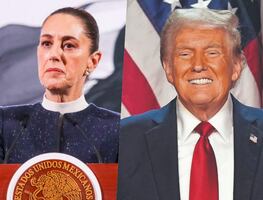Más Información

¿Maíz transgénero? Rubén Rocha corrige desliz durante discurso en Sinaloa; destaca importancia del maíz blanco

Sheinbaum asegura apoyo total a Sinaloa para enfrentar violencia; "Nunca los vamos a dejar solos, aquí está la presidenta"

Dictan 600 años de prisión a "El Negro" Radilla y "El Cone"; responsables de secuestrar al hijo de Javier Sicilia

Familias de desaparecidos en Mazatlán irrumpen en evento de Sheinbaum; mandataria promete atender peticiones

Sheinbaum responde a Trump sobre declarar a cárteles como organizaciones terroristas; rechaza injerencia extranjera
According to James Oles – American researcher specializing in Latin American art – cultural transvestism is a critical concept which can be used to study the works of characters who dress themselves in clothing from other cultures. While the exact origin of this practice is unknown, Oles said the renewed interest in this practice began during the European Colonialism.
“ Rembrandt appears in one of his self-portraits with a turban and a feather. It's a distant reference to the Turkish culture and the exoticism in vogue,” he said, explaining that many criticize such paintings because they only see the European appropriating other cultures, however, others believe there's a certain feeling of empathy for the cultures advocating for a more liberal society.
About the specific case of Frida Kahlo , Oles referred to the "Self-portrait with Monkey and Parrot" where the artist depicts herself dressed in a huipil – a rectangular garment used by the women of the Tehuantepec Isthmus.
“She adopts this clothing at the beginning of the 30's,” he said, “She was an upper-class girl, her father was German, and she was ' Mexicanized' by Rivera , who turned her into the typical Mexican woman.”
Although this is just one interpretation, Oles pointed out Kahlo wasn't the first woman to dress in indigenous fashion, mentioning the work of painter Saturnino Herrán in 1914.
“The political intention during the 20's was to transform regional into national; building a shared nationalist spirit was one of the greatest concerns of the intellectuals during the Mexican Revolution. ”
However, Frida Kahlo made it an international symbol.
“The cultural transvestism of Kahlo has a creative aspect to it, and it's her construction, a theatricalization,” said Oles, stating it was part of the myths Diego Rivera and Frida Kahlo built around their life.
“I'm surprised we still believe what artists say about themselves,” Ole added, saying that while there is some truth to Rivera and Kahlo's “versions” of their story, several things of what they said should be questioned.
“They were great mystifiers of their own lives.”
am





